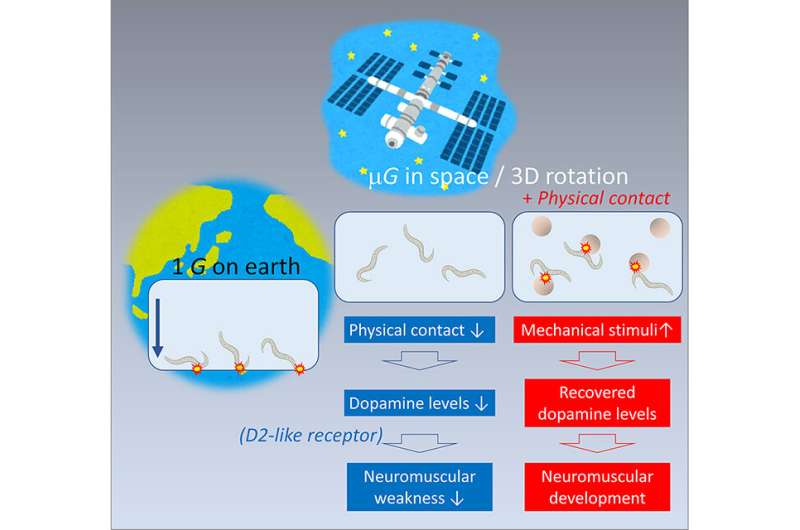Microgravity worms help solve astronauts’ muscle troubles

A new study on nematode worms reveals that physical contact with objects can help prevent neuromuscular decline in simulated microgravity. The research, which was published in the journal iScience, provides new insights into maintaining human health in space.
Over the past 60 years, hundreds of humans have flown into space, sometimes spending up to a year on the International Space Station. Spaceflight subjects the body to near weightlessness or microgravity, which can negatively impact health.
“Progressive neuromuscular decline in microgravity is a major health concern for humans spending time in space,” explains Atsushi Higashitani, a molecular biologist at Tohoku University. “Our international team investigated the underlying reasons for these changes.”
The researchers studied Caenorhabditis elegans, a nematode worm that shows similar molecular and physiological effects to humans during spaceflight, including impaired muscle performance and reduced body length.
They tested worms grown in space and in simulated microgravity on Earth for the levels of two molecules: dopamine, a chemical messenger in the nervous system known to be involved in movement and detecting physical contact, and COMT-4, an enzyme responsible for breaking down dopamine.
They found that the microgravity-grown worms had reduced levels of both molecules. The dopamine levels in space-grown worms were less than half the levels found in worms grown under normal gravity conditions, making them swim more slowly. Administering dopamine reversed these effects, restoring normal movement and body length.

Next, the researchers tested whether the neuromuscular decline was a direct result of microgravity or an indirect effect of reduced physical contact. They compared adult worms grown in simulated microgravity conditions, which were placed in physical contact with plastic microbeads or in liquid where they were buoyant and lost contact with the base of the dish. The dopamine and COMT-4 levels did not decline in the first group and the worms showed normal movement.
Additionally, muscle calcium levels were reduced in adult worms grown in microgravity but were restored when the worms were placed in contact with the microbeads. Calcium plays an important role in muscle contraction by creating interactions between key proteins.
Overall, these results imply that the lack of physical contact that happens during near-weightlessness reduces dopamine levels and in turn causes neuromuscular impairments.
“We uncovered a pathway between physical contact, dopamine and muscle regulation that controls neuromuscular health in microgravity,” says Higashitani. “Introducing physical contact re-establishes this pathway and helps to restore muscle function.”
This study suggests that targeting the dopamine system through physical contact with objects can prevent muscular decline and is a realistic treatment strategy to promote safe human deep-space travel. Gentle mechanical contact, such as hand and foot massages, could be used to maintain neuromuscular health in astronauts and might even help elderly people with impaired motor function.
Space worms experiment reveals gravity affects genes
Surabhi Sudevan et al, Loss of physical contact in space alters the dopamine system in C. elegans, iScience (2022). DOI: 10.1016/j.isci.2022.103762
Citation:
Microgravity worms help solve astronauts’ muscle troubles (2022, February 15)
retrieved 16 February 2022
from https://phys.org/news/2022-02-microgravity-worms-astronauts-muscle.html
This document is subject to copyright. Apart from any fair dealing for the purpose of private study or research, no
part may be reproduced without the written permission. The content is provided for information purposes only.
For all the latest Science News Click Here
For the latest news and updates, follow us on Google News.

